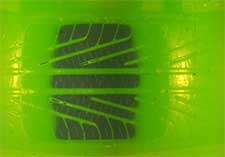Advantages of Correct Tyre Inflation
Maintaining correct tyre inflation pressure helps optimize tyre performance and fuel economy. Correct tyre inflation pressure allows drivers to experience tyre comfort, durability and performance designed to match the needs of their vehicles. Tyre deflection (the tread and sidewall flexing where the tread comes into contact with the road) will remain as originally designed and excessive sidewall flexing and tread squirm will be avoided. Heat buildup will be managed and rolling resistance will be appropriate. Proper tyre inflation pressure also stabilizes the tyre’s structure, blending the tyre’s responsiveness, traction and handling.
Disadvantages of Under inflation
An underinflated tyre can’t maintain its shape and becomes flatter than intended while in contact with the road. If a vehicle’s tyres are underinflated by only 6 psi it will weaken the tyre’s internal structure and eventually lead to overheating of the tyre carcass which will if left unchecked lead to tyre failure. Increased rolling resistance (causing a reduction in fuel economy of up to 5%) and reduce the tyre’s tread life by as much as 25% while increasing the probability of irregular treadwear. Drivers would also find a noteworthy loss of steering precision and cornering stability. While 6 psi doesn’t seem excessively low, it typically represents about 20% of a passenger car tyre’s recommended pressure.
Disadvantages of Over inflation
An over inflated tyre is stiff and unyielding and the size of its footprint in contact with the road is reduced. If a vehicle’s tyres are over inflated by 6 psi, they could be damaged more easily when encountering potholes or debris on the road, as well as experience irregular tread wear. Higher inflated tyres cannot isolate road irregularities as well causing the vehicle to ride harsher and transmit more noise into its interior. However, higher inflation pressures reduce rolling resistance slightly and typically provide a slight improvement in steering response and cornering stability. This is why participants who use street tires in autocrosses, track events and road races run higher than normal inflation pressures.
Maintenance Tips to Increase Tyre Performance, Life and Durability
Check and Adjust First Thing In The Morning. Set according to the vehicle manufacturer’s cold tire pressure(s) recommended on the vehicle’s tyre placard or in its owner’s manual. This must be done before rising ambient temperatures, the sun’s radiant heat or even driving short distances temporarily warms the tyres.
Accommodating Variables
Indoor-to-outdoor Temperature Variation
Significant differences between the conditions tyre pressures are set (the warmth of an attached garage, heated garage or service shop) and in which the vehicle will be driven (winter temperatures) requires inflating tyres 1 psi higher than recommended on the placard for every 5.0 deg C. difference in temperature between interior and exterior temperatures.
Afternoon Ambient Temperature Increase
Set 2 psi above vehicle manufacturer’s cold inflation recommendations when installing new tyres or if the vehicle has been parked in the shade for a few hours. Tyre Heat Generated While Being Driven (or at speeds of less than 75 kph)).* – Set 4 psi above vehicle manufacturer’s cold inflation recommendations.
Heat Generated While Being Driven Extensively
(or at sustained speeds greater than 75 kph). Set 6 psi above vehicle manufacturer’s cold inflation recommendations.
Do Not Release Hot Tyre Pressure
If any of these variables could be the cause of measured tyre pressure exceeding the maximum psi branded on the tyre’s sidewall by the 2, 4 or 6 psi indicated above for the various conditions. This temporary pressure increase is expected and designed into the tyre’s capabilities. NOTE: Tyres on a parked vehicle exposed to direct sunlight will appear overinflated due to the heat absorbed from the radiant energy of the sun. Pressures cannot be accurately set on these tyres until all have stabilized in the shade.
Air Pressure vs. Wet Performance
Most drivers realize that tyre load capacity is determined by tyre size and inflation pressure. Larger tyres and higher inflation pressures provide more load capacity, while smaller tyres and lower tyre pressures provide less.
An underinflated tyre will tend to wear the shoulder areas of the tread faster than the center. This is because there is insufficient air pressure to allow the center of the tread to carry its fair share of the weight. A correctly inflated tyre receives appropriate support from the contained air pressure to provide an even distribution of load across the footprint. And while most drivers recognize that this has a significant impact on tyre wear, rolling resistance and durability, only a few realize it also has a noticeable influence on how effectively the tyres can resist hydroplaning to maintain wet traction.
As they taught us in physics class, you can compress and move a gas quite easily, but you cannot compress liquids and it requires significant energy to move them. Our tyres easily push air around and through their tread designs as they roll. However, when water pools in highway ruts and builds up on the road surface during rainstorms, the vehicle’s speed and weight, as well as the tyres’ tread designs, tread depths and evenness of their footprint pressures determines if and when the tyres will be forced to hydroplane.
One of the ways tyre manufacturers evaluate their products’ hydroplaning and wet traction effectiveness is by driving them over a glass plate covered with a specific depth of water. The water is dyed for better visibility and to allow high-speed cameras in underground rooms to photograph the tyres from below. Michelin has provided several photographs of its HydroEdge premium All-Season tyre to help illustrate this tech feature.

Pic.1 shows a tyre properly inflated to 35 psi sitting still in the water on the glass plate. This provides an accurate idea of the tyre’s footprint size and shape. The black area is where the tyre’s rubber compound is pressed on the glass, and the green areas identify water in the tyre’s circumferential and high-angle lateral grooves, and on the remainder of the glass plate.
A properly inflated tyre will have enough pressure in the center of its tread to resist collapsing.

Pic.2 is of a tyre properly inflated to 35 psi, driving across the glass at 100 kph. If the glass plate were dry, the footprint size would be virtually identical to the first picture because air does not prevent the tread from contacting the plate. However with standing water on the plate, the tyre’s tread depth and tread design must evacuate the water as the tyre rolls across the plate at 88 feet per second. You will notice that the footprint still shows good contact with the plate, but is slightly smaller than the static tyre’s footprint.
A tyre that is slightly underinflated will apply less pressure to the center of the tread and it will become slightly concave.

Pic.3 is of a tyre inflated to only 30 psi, again driving across the glass at 100 kph. With the same amount of standing water on the plate, the center of the tyre’s tread is lifted as the tread design unsuccessfully attempts to evacuate water as the tyre rolls across the plate. You will notice that the actual footprint shows poor contact with the plate and is significantly smaller than the footprint in the photograph of the properly inflated tyre.
A tyre that is significantly underinflated will allow the center of the tread to collapse and become very concave, trapping water rather than flowing it through the tread design.

Pic.4 is of a tyre inflated to only 25 psi, driving across the glass plate at 100 kph. With the same amount of standing water, the water lifts the center of the tyre’s tread as its footprint rolls across the plate. You will notice that the actual footprint shows little contact with the plate and has been virtually reduced to the shoulder areas.
Members of the Tire Rack team had the chance to experience the effects of air pressure on wet performance at Michelin’s Laurens Proving Grounds. Drivers were given the opportunity to compare identical cars on a wet-handling course with the exception of one car having four properly inflated tires (35 psi) and the other car having significantly underinflated tyres on the rear axle (25 psi).
While driving at the edge of a tyre’s ability in wet conditions is challenging, the car with the properly inflated tyres provide handling that was predictable. Driving the car with the underinflated rear tyres proved to be much more difficult to drive and forced the driver to slow down to retain control, producing lap times that were several seconds slower than the properly inflated car. While tyre manufacturers can develop tyres with great hydroplaning resistance and wet traction, poor maintenance of tyre inflation pressures can make a great tyre awful.
Adjust your tyre pressures as indicated on the vehicle tyre placard or in the owner’s manual. Check your inflation pressures at least once a week and before highway trips. Stick to these simple guidelines and you will enjoy longer tyre life, better fuel economy and safer handling.
![]()
